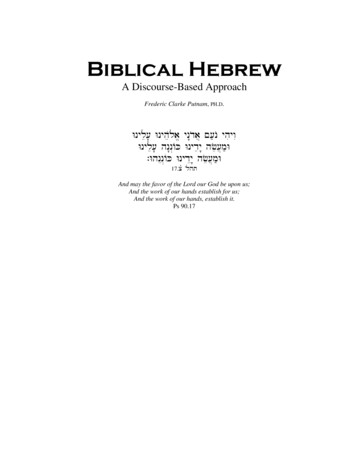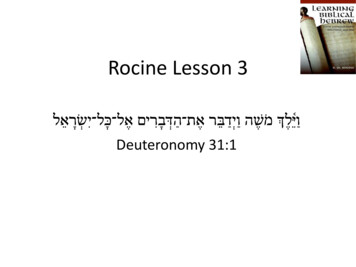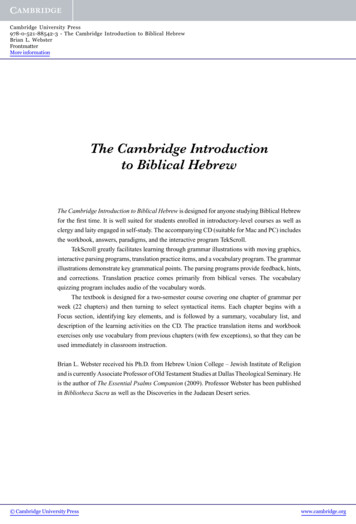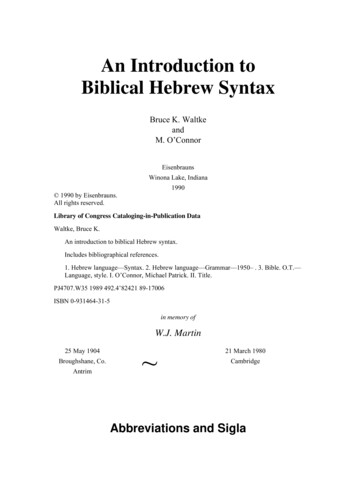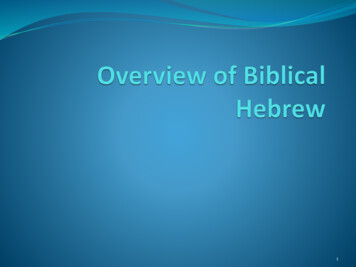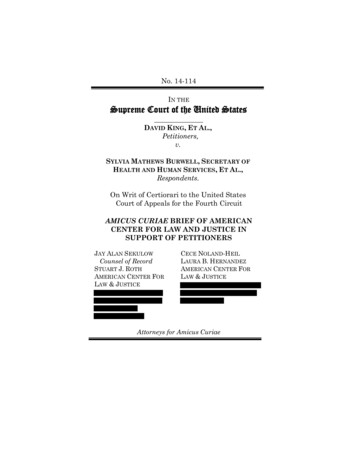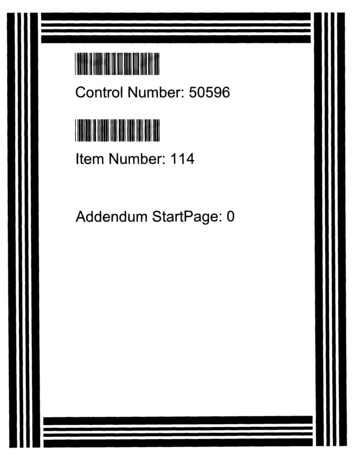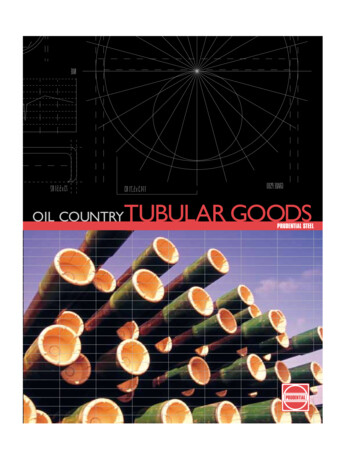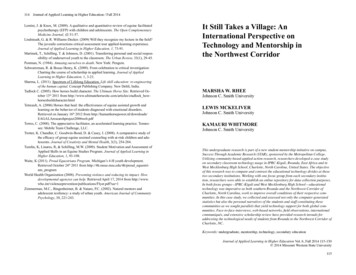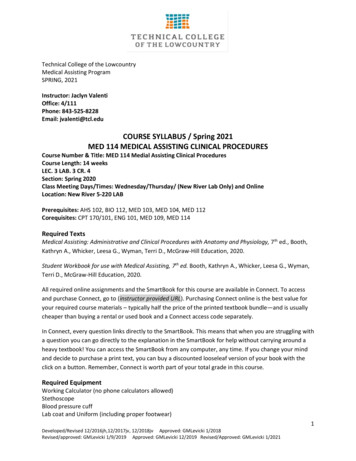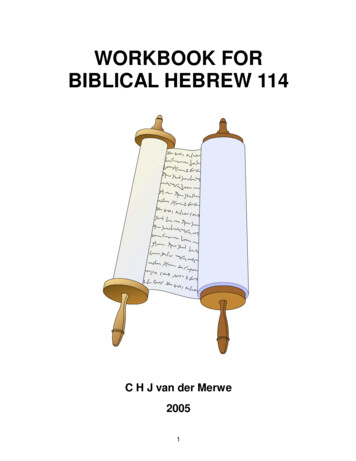
Transcription
WORKBOOK FORBIBLICAL HEBREW 114C H J van der Merwe20051
Table of ContentsSECTION A12THE ANCIENT NEAR EAST: A SHORTGEOGRAPHICAL AND HISTORICAL SURVEY121. THE ANCIENT NEAR EAST AND ITS PEOPLE: I131.1 Introduction13PowerPoint Presentation 1131.1.1 Which nations lived in the region?131.1.2. Historical survey131.2 The third millennium14PowerPoint Presentation 2141.2.1 Sumerians141.2.2 Akkad151.2.3 Egypt151.2.4 Syro-Palestine161.3 The second millennium16PowerPoint Presentation 31.3.1 Ancient Babylon16161.3.2 Egypt171.3.3 Syro-Palestine171.4 Review:181.5. The Ancient Near East and its People: overview182. THE ANCIENT NEAR EAST AND ITS PEOPLE: II202.1 The first millennium20PowerPoint Presentation 4202.1.1 Egypt202.1.2 Neo-Assyria202.1.3 Neo-Babylonian Kingdom2.1.4 The Persian Kingdom21212.2 Review:222
3. SYRO-PALESTINE: A GEOGRAPHICAL AND HISTORICALSURVEYPowerPoint Presentation 523233.1 Regions233.1.1 Phoenicia3.1.2 Aram23233.1.3 The Philistines233.1.4 Moab, Ammon and Edom243.1.5 Israel24SECTION B27INTRODUCTION TO BIBLICAL HEBREW274. THE HEBREW ALPHABET: CONSONANTS284.1 Excerpt28§ 4 The alphabet - consonants28§ 4.1 The form of consonants284.2 The forms of the consonants324.3 Exercise: consonants334.3.1a Interactive exercises33Lesson 1. Learn the names of the consonants4.3.1b Fill in the missing consonant33334.3.2a Interactive exercisesLesson 2. Learn to the numerical value of consonantsLesson 3. Learn the alphabetic order of consonants4.3.2b Write down the Hebrew alphabet in the correct order and give each letter its name:34Error! Bookmark not defined.4.3.3 Answer the following questions:4.3.3a Interactive exercisesLesson 4:Lesson 5:Lesson 6:Lesson 7:35Definitions of consonantsTypes of consonantsConsonants with alternative pronunciationsBegadkefat consonants353535354.3.3b Answer the following questions:354.3.4 Transliteration and identification of consonants365. THE HEBREW ALPHABET: VOWELS375.1 Excerpt: the vowels375.2 Exercises: vowels415.2.1a Interactive exercises41Lesson 8: Pronunciation of the vowels413
5.2.1b Recognising the pronunciation of BH vowels415.2.2 Graphical representation of BH vowels425.2.3 Recognising the names of BH vowels435.2.3a Interactive exercises43Lesson 9: Names of vowels435.2.3b Recognising the names of BH vowels435.2.4 Assorted exercises445.2.4a Interactive exercises44Lesson 11: Characteristics of vowels: Vowel indicatorsLesson 11: Characteristics of vowels: Full and defective writing44445.2.4b Assorted exercises445.2.5a Interactive exercises45Lesson 10. The classification of vowelsLesson 14 Listen to excerpts from 1 Sam 3:1-3Lession 15 Listen to excerpts from 1 Sam 3:4-85.2.5b Reading ability and the recognition of vowels6. WORLDVIEW , GEOGRAPHY, DIPTHONGS AND ACCENTUATION6.1 Dipthongs and accent6.1a Interactive exercises:45454545454649Lesson 12: The pronunciation of diphthongsLesson 12: The identification of open and closed syllablesLesson 12: The identification of accents6.1b Instruction: diphtongs and accentuation6.2 Worldview4949494949PowerPoint Presentation 6496.3 Geography of Israel (See 1.3.3 “Israel”)50PowerPoint presentation 7506.3.1 The coastal plain506.3.2 The highlands of Judah and Ephraim (Samaria)516.3.3 The plain of Jezreel 516.3.4 The Jordan Valley516.3.5 The Eastern Jordan region (Transjordan-plateau)526.4 Exercise: Recognition of BH lexemes: geography536.4 Exercise: Recognition of BH lexemes: geography54Fill in the missing English equivalents:547. MASORETIC SIGNS AND DIVISION OF TIME557.1 Remarks regarding Masoretic signs557.2 Division of time 57Powerpoint presentation 8574
7.3a Interactive exercises57 Lesson 13: Masoretic signs with double functions: 577.3b Exercise: Masoretic signs577.4 Vocabulary exercise: Time588. CULTURAL HISTORY I598.1 The world of the patriarchs59Powerpoint Presentation 955Powerpoint Presentation 10558.2 Vocabulary-exercise: The world of the patriarchs618.2.1 Fill in the missing English equivalent618.2.2 Circle the correct Hebrew word where necessary639. CULTURAL HISTORY II AND ADJECTIVES I659.1 Israel in Egypt and the exodus (1550-1280 BC)659.2 Adjectives659.3 Vocabulary exercise: Israel in Egypt and the exodus669.3.1 Fill in the missing English equivalent669.3.2 Circle the correct Hebrew word where applicable6610. NUMBER, GENDER AND DEFINITENESS6810.1 Gender and number6810.1.1 The grammar and semantics of gender in BH10.2 Definiteness6910.2.1 The morphology of10.2.2 The semantics of69 70 7010.3 The adjective II7010.3.1 The predicative use of the adjective7010.3.2 The attributive use of the adjective7110.4 Adjectives and vocabulary exercises7110.4.1 Questions regarding the syntactic use of adjectives7110.4.2 Identify the adjective7110.4.3 Reading exercise7211. CULTURAL HISTORY III AND CONJUCTIONS I7311.1 The entry and establishment (1280-1020 BC)7311.2 The conjunctions and 755
11.3 Vocabulary exercise: The entry and establishment7611.3.1 Fill in the missing English equivalents7611.3.2 Parse the following forms:7612. CULTURAL HISTORY IV AND PREPOSITIONS I7712.1 The living conditions in the period: 1280-1020 BC7712.2 Prepositions7812.2.1 The semantics (meaning) of prepositions7812.2.2 Morphology of Prepositions7812.3 Vocabulary-exercises: Living conditions 1280-1020 BC8012.3.1 Fill in the missing Hebrew equivalentError! Bookmark not defined.12.3.2 Fill in the missing English equivalent8013. CULTURAL HISTORY V81PowerPoint Presentation 118113.1 The family and social organisation of the period: 1280-1020 BC81PowerPoint Presentation 128113.1.1 The social unit: The extended family, the clan and the tribe8114. STATUS CONSTRUCTUS86PowerPoint presentation 138614.1 Morphology and syntax8614.2 Exercise in the analysis of status constructus forms I8714.3 Exercise in analysing the status constructus forms II8814.4 Vocabulary exercise8914.5 Word analysis8915. CULTURAL HISTORY VI9015.1 The religious situation in the period : 1280-1020 BC9015.2 Vocabulary exercise: The religious situation between 1280-1020 BC9215.2 Vocabulary exercise: The religious situation between 1280-1020 BC9315.2.1 Fill in the missing English equivalent9315.2.2 Choose the correct Hebrew expression or, where required, fill in the Englishequivalent9516. CULTURAL HISTORY VII9716.1 The uniqueness of the world of the Bible976
16.2 Names of the external body parts and their metaphoric use97PowerPoint presentation 1497 head16.2.2 ear16.2.3 eye 16.2.4 nose (the plural/dual form refers to a person’s nostrils)16.2.5 lips16.2.6 hand16.2.7 palm (this may also refer to the palm of a person’s foot)16.2.8 arm16.2.9 foot16.2.10 Body9716.2.116.3 Names for the organs and their metaphoric uses:97989898989999999910116.3.1 throat, life, self10116.3.2 / heart101 16.3.3 kidneys10216.3.4 liver10216.3.5 entrails10216.3.6 abdomen, uterus10316.4 Representation of “self”10316.5 wind/spirit/breath10316.6 Vocabulary exercise: body parts and organs10417. PRONOUN I10717.1 Independent personal pronoun10717.1.1 Read the following excerpt from 1 Sam 1:15-16:10717.1.2 Fill in the missing independent personal pronoun in the following sentences:10717.1.3 Paradigm of the independent personal pronouns10817.2 Demonstrative pronouns10917.2.1 Semantics of demonstrative pronouns10917.2.2 Syntax of demonstrative pronoun10917.2.3 Paradigm of the demonstrative pronoun10917.3 Interrogative words11017.3.1 Factual interrogative pronouns and17.3.2 Yes/no interrogtive words1101107
17.4 Exercise: pronoun11117.4.1 Fill in the missing pronoun in the following sentences11117.4.2 Decide in the following examples between (a) interrogative pronouns and (b) yes/nointerrogative words11117.4.3 Translate the following expressions11118. PRONOUNS II11218.1 Personal suffixes11218.1.1 Introduction11218.1.2 Paradigms of personal suffixes11218.2 Exercises: personal suffixes11418.2.1 Recognising personal suffixes attached to nouns11418.2.2 Parsing and translating of expressions with personal suffixes11519. PRONOUNS III: PERSONAL SUFFIXES FOR PREPOSITIONS CULTURAL HISTORY VII11919.1 Personal suffixes for prepositions11919.2 Transition to the monarchy: the nation asks for a king (1 Sam 8)12019.3 Exercise: Recognition of personal suffixes and vocabulary12120. VERBS I12320.1 Verbs and the manner in which sentences are constructed12320.1.1 Subject and predicate12320.1.2 Complements and adjuncts12420.2 Exercise in the recognition of sentence parts21. VERBS II12512721.1 Characteristics of verbs12721.1.1 Introduction12721.1.2 Outstanding characteristics of BH verbal forms12721.2 Qal perfect conjugation12821.3 Meaning of the Qal perfect form12821.4 Exercise: Verbs II12921.5 Vocabulary1328
22. VERBS III13322.1 Qal imperfect conjugation13322.1.1 Introduction13322.2 Meaning of the Qal imperfect form13422.3 Exercise: Verb III13523. WORD ORDER IN BH SENTENCES23.1 Nominal sentences13713723.1.1 The unmarked order in a nominal sentence is:23.1.2 The marked order in nominal sentence is:23.2 Verbal sentences13713713723.2.1 If all the sentence constituents are lexicalised, the unmarked order in verbalsentences:13723.2.2 The marked order in nominal sentences is:13724. CULTURAL HISTORY VIII13924.1 The monarchy (1020-587BC)13924.2 First kingdom: (1020-922 BC)13925. THE DIFFERENT TYPES OF 14225.1 The copulative14225.2 The consecutive14225.3 copulative and consecutive: exercise14326. VERBS IV: DIRECTIVE: IMPERATIVE, JUSSIVE ANDCOHORTATIVE14526.1 Jussive and jussive form14526.2 Cohortative and cohortative form14526.3 Imperative forms14626.4 Negative requests and commands14626.5 Series of commands and requests14626.6 Directive: exercise1479
27. VERBS V: THE INFINITIVE CONSTRUCT (INF. CS.)14927.1 Vocabulary14927.2 Form of the inf. cs.14927.3 Uses of the inf. cs.15027.4 Negation of the inf. cs.15127.5 Exercises: inf. cs.15128. VERBS VI: THE INFINITE ABSOLUTE AND PARTICIPLE15328.1 Vocabulary15328.2 The form of the infinite absolute (inf. abs.)15328.3 The uses of the inf. abs.15328.4 Participle15428.4.1 Form of the participle15428.4.2 Syntax15428.4.3 Uses of the participle15428.5 Exercise: inf. abs. and participle15529. WORD LIST157ADJECTIVES157ADVERBS157DISCOURSE MARKERS158NOUNS158Abstract nouns158Common nouns158AnimalsProper Names159159Geography161Food162Body parts and internal organs162Cultic objects163Politics/religion163Spatial designations164Social structure164Temporal designations165CONJUNCTIONS165PRONOUNS16510
Independent personal pronouns166Demonstrative prounouns prounPropronouns166Question Words166VERBS166PREPOSITIONS16911
SECTION AThe Ancient Near East:a short geographical and historicalsurvey12
1. The Ancient near East and its people: I1.1 IntroductionPowerPoint Presentation 11.1.1 Which nations lived in the region?The Egyptians, Nubians, Ethiopians, Canaanites, Phoenicians, Israelites, Moabites,Philistines, Edomites, Ammonites, Hittites, Hurites, Sumerians, Assyrians, Kassites,Babylonians, Chaldeans, Amorites, Elamites and Persians.It is important to take into consideration the historical perspective of who lived whereand when.1.1.2. Historical survey3rd millennium: Sumerians (the first cities and cuneiform writing), Akkadians, Egyptians(hieroglyphics are developed and the pyramids built)2nd millennium: Old-Assyrian and Ancient Babylonian Empire; the literature of Egyptemerges and the Egyptians are influential in Palestine. In particular, they were engagedin conflict with the Hittites and Hurites.1st millennium: In this millennium, the Egyptian Empire goes into decline. A number ofsmaller cultures emerge: e.g. the Phoenicians, Philistines, Arameans, Israelites,13
Moabites, Edomites and Ammonites. The seat of power has moved to the Assyrians,Babylonians, Persians, Greeks and Romans.1.2 The third millenniumPowerPoint Presentation 2Mesopotamia: overviewMesopotamia: Sumeria1.2.1 SumeriansSumeria refers to an area south of Iraq situated between the Tigris and EuphratesRivers. The Bible refers to these two rivers in Gen 2:14. The Greeks called it the landbetween the rivers (Mesopotamia). The Sumerians were the first culture to use a formof writing. This cuneiform writing was usually done on clay tablets.The area in which the Sumerians lived was poor in stone, wood and metals. Insteadthey farmed on the fertile silt, which the two rivers carried down from the north.Contrary to the Nile, the flow of these rivers was unreliable. It seldom rained and thepeople were forced to develop innovative ways of using the river water effectively. Muddams, canals and the first shadufs were built. Most of the population settled in themarsh deltas, which were full of reeds. Here the first cities, such as Ur, Uruk andNippur, developed. The drier regions between the cities were much more sparselypopulated. This led to the political development of the various cities into independentcity states, each with their own deity and king. The heart of these city states were theirextensive temple complexes.A surplus of agricultural products and an industry producing pottery wares and clothingenabled the Sumerians to trade for raw materials such as wood and stone. For thispurpose they built sailing boats, with which they traveled in the Persian Gulf. Towardsthe west, they developed caravan routes.Constant tension existed between the city states. When war threatened, a ruler (calleda lugal) was appointed by a council of elders for the duration of the crisis. In time, rulersreceived more permanent status and began to take over the role of the elders. Theauthority of the king was also expanded and he began to appoint his own successor.14
Furthermore, he acted as priest and judge. Among the oldest laws recorded are thoseof Ur-Nammu (circa 2000 BC).One of the Sumerian kings who managed to subjugate a number of other city stateswas Lugalzagezi. However he met his match in Sargon I
BIBLICAL HEBREW 114 C H J van der Merwe 2005. 2 Table of Contents SECTION A 12 THE ANCIENT NEAR EAST: A SHORT GEOGRAPHICAL AND HISTORICAL SURVEY 12 1. THE ANCIENT NEAR EAST AND ITS PEOPLE: I 13 1.1 Introduction 13 PowerPoint Presentation 1 13 1.1.1 Which nations lived in the region? 13 1.1.2. Historical survey 13 1.2 The third millennium 14 PowerPoint Presentation 2 14


